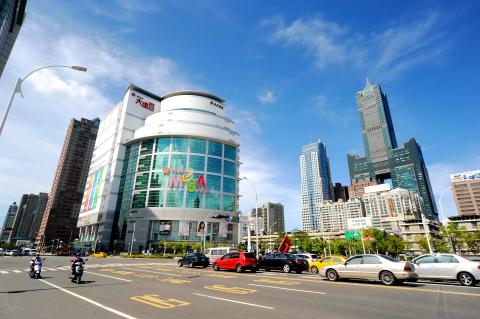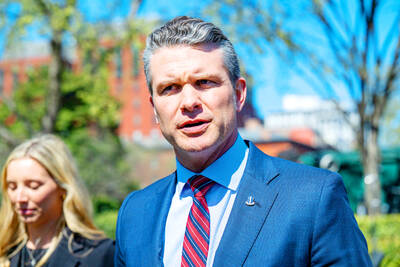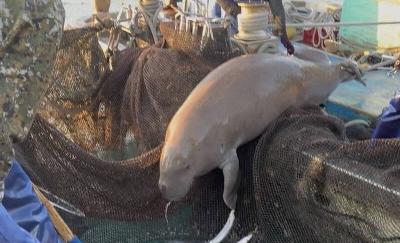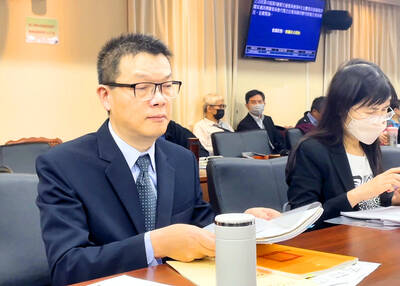Prompted by questions posed by foreign tourists, residents are now pondering Greater Kaohsiung’s apparent listless atmosphere and the lack of economic activity in the southern port city.
Recently, questions posted on the Mobile01 Web site by a group of backpackers from Malaysia (“What is happening to Kaohsiung? Why are there so few people on the streets?”) generated lively on-line debates and elicited much response.
In addition, Kaohsiung is barely mentioned on one popular backpacker information Web site.

Photo: Chang Chung-i, Taipei Times
In response, one netizen wrote: “[If I had] to recommend a place to visit in southern Taiwan, it would be Tainan or Kenting, because those cities have more special characteristics than Kaohsiung.”
Another netizen responded by saying: “Kaohsiung is a growing city making steady progress, but there is still a lack of jobs and little population growth.”
Others said: “There are so few passengers on the Kaoshiung MRT, and you don’t see much major construction or business activities.”
Defending the city’s reputation, several individuals wrote: “I really like Kaohsiung, just because it is not so crowded, has a slower pace of life, while it does offer the convenience and prosperity of a big city.”
Another replied: “There are so many good places to visit around Kaohsiung, like the harbor area, Chaishan Park (柴山), Cijin (旗津) Fishery Port, the World Games Stadium, Heart of Love River (愛河之心) and others. You would need more than a day to visit each of these famous tourist sites.”
A local restaurant owner, surnamed Chen (陳), said that Kaohsiung’s economy is struggling, and that he has lost between 20 percent and 30 percent of his business compared with previous years. He noticed that not many people are on the streets after 9pm.
A night market vendor, surnamed Su (蘇), contended that to revive the economy, the city should not depend on tourists from China.
He said that most people are constrained in their activities by the stagnant economy and are cutting their spending. So, instead of asking: “What is happening to Kaohsiung?” the question should be: “What is happening to Taiwan?”
An official from Greater Kaohsiung’s Economic Development Bureau replied that the bureau respects the views expressed in the online discussion sites, but in reality it is not just Kaohsiung, but the whole of Taiwan that is affected by a weak economy.
He said this has affected people’s willingness to travel, shop and spend money on goods.
He said that the economy is forecast to improve in the near future and once the port facility expansion project, Kaohsiung Asia New Harbor (亞洲新灣區), is completed, Kaohsiung will experience a new period of economic growth.
One bright spot this year is the Kaohsiung Pier 2 Art District (駁二藝術特區) which, according to its own data, attracted more than 1.9 million visitors from January to this month, surpassing visitor numbers for the whole of last year.
Its own survey results indicated many visitors were backpackers from Hong Kong, Macau, Singapore and Malaysia.
The Greater Kaohsiung Government pointed out that major tourist attractions have set new highs for visitor numbers in the first half of this year.
Topping the list is the Fo Guang Shan Monastery (佛光山), with more than 6.69 million visitors, far ahead of other scenic sites around Kaohsiung.
A total of 18 major tourist attractions were categorized in an analysis of economic activities of Greater Kaohsiung, undertaken on behalf of the local government.
These included Maolin Scenic Area, the Baolai Hot Springs Area, Shoushan Zoo, the Former British Consulate at Takao, the Kaohsiung Museum of Fine Arts, the Meinung Hakka Culture Museum, Cheng Ching Lake Scenic Area, Fo Guang Shan Monastery, the Yang Min Museum of Marine Exploration, the National Science and Technology Museum, the Heart of Love River, Cijin Fishery Port and Kaohsiung Pier 2 Art District.
For these 18 major Kaohsiung tourist attractions, visitor numbers have gone up from 8.07 million in 2008 to 12.48 million last year. Visitor numbers have already reached 16.28 million for the first half of this year, higher than the whole of last year.
Of all attractions, Fo Guang Shan Monastery has the most impressive numbers, with 6.59 million for the first half of this year, followed by Cijin Fishery Port with 2.7 million. In third place is the Kaohsiung Pier 2 Art District with 2.7 million and the National Science and Technology Museum is ranked fourth with 1.39 million for the same period.
The hotel occupancy rate in Kaohsiung was 64.96 percent for the first half of this year, higher than the 61.92 percent recorded during the same period last year.
Tourism bureau information indicated that most of the increase was due to 83,000 Chinese tourists who visited in the second quarter of this year, followed in second place by 50,000 Japanese tourists.

‘DENIAL DEFENSE’: The US would increase its military presence with uncrewed ships, and submarines, while boosting defense in the Indo-Pacific, a Pete Hegseth memo said The US is reorienting its military strategy to focus primarily on deterring a potential Chinese invasion of Taiwan, a memo signed by US Secretary of Defense Pete Hegseth showed. The memo also called on Taiwan to increase its defense spending. The document, known as the “Interim National Defense Strategic Guidance,” was distributed this month and detailed the national defense plans of US President Donald Trump’s administration, an article in the Washington Post said on Saturday. It outlines how the US can prepare for a potential war with China and defend itself from threats in the “near abroad,” including Greenland and the Panama

A wild live dugong was found in Taiwan for the first time in 88 years, after it was accidentally caught by a fisher’s net on Tuesday in Yilan County’s Fenniaolin (粉鳥林). This is the first sighting of the species in Taiwan since 1937, having already been considered “extinct” in the country and considered as “vulnerable” by the International Union for Conservation of Nature. A fisher surnamed Chen (陳) went to Fenniaolin to collect the fish in his netting, but instead caught a 3m long, 500kg dugong. The fisher released the animal back into the wild, not realizing it was an endangered species at

The High Prosecutors’ Office yesterday withdrew an appeal against the acquittal of a former bank manager 22 years after his death, marking Taiwan’s first instance of prosecutors rendering posthumous justice to a wrongfully convicted defendant. Chu Ching-en (諸慶恩) — formerly a manager at the Taipei branch of BNP Paribas — was in 1999 accused by Weng Mao-chung (翁茂鍾), then-president of Chia Her Industrial Co, of forging a request for a fixed deposit of US$10 million by I-Hwa Industrial Co, a subsidiary of Chia Her, which was used as collateral. Chu was ruled not guilty in the first trial, but was found guilty

DEADLOCK: As the commission is unable to forum a quorum to review license renewal applications, the channel operators are not at fault and can air past their license date The National Communications Commission (NCC) yesterday said that the Public Television Service (PTS) and 36 other television and radio broadcasters could continue airing, despite the commission’s inability to meet a quorum to review their license renewal applications. The licenses of PTS and the other channels are set to expire between this month and June. The National Communications Commission Organization Act (國家通訊傳播委員會組織法) stipulates that the commission must meet the mandated quorum of four to hold a valid meeting. The seven-member commission currently has only three commissioners. “We have informed the channel operators of the progress we have made in reviewing their license renewal applications, and